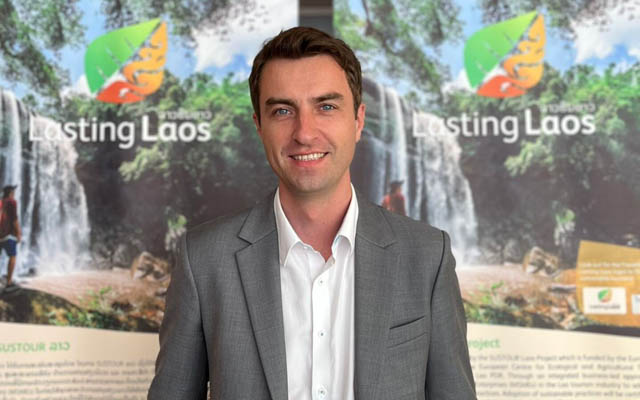The four-year SUSTOUR Laos project aims to improve sustainability by integrating local tourism businesses into the supply chain through the promotion and certification of sustainable business practices, says project manager, Connor Bedard
 What is SUSTOUR?
What is SUSTOUR?
The project is funded by the European Union and runs under Plan International, an NGO that primarily focuses on the advancement of children’s rights, health and access to education. In the last few years, we have focused more on economic development and livelihoods, and recognise there are many employment opportunities for young adults in Laos’ tourism and hospitality sector. Our partners are Lao National Chamber of Commerce and Industry, and the European Centre for Ecological and Agricultural Tourism, who developed the Travelife certification. The aim is to promote sustainable consumption and production practices by getting more tourism businesses Travelife accredited.
Why is getting Travelife certification important?
Travelife is the leading certification in terms of sustainability in the tourism sector. The benefits we see is recognition of businesses as sustainable, lower operating costs, and increased customer satisfaction. We see more and more the trend is tourists looking for sustainable tour operators and accommodation. Travelife also helps to reduce greenwashing. A lot of businesses can call themselves sustainable but have they actually tried to prove it?
What has been the outcome so far?
Seven tour operators and DMCs already had Travelife accreditation in Laos but no hotels. Travelife isn’t that well-known with local companies in Laos, so the companies that already had it tend to be regional, like Khiri Travel. One of the first things we did when the project started was to give introductory training to 81 tourism businesses on Travelife. Out of those, 68 have registered in the system but there are varying degrees on the staff and time businesses can allocate, as the reporting and internal management process takes time. There are about 10 frontrunners in the group, which we expect to be ready to audit in November and are confident they will receive certification. We will then give those businesses a promotional platform.
What is the pace of sustainable tourism in Laos?
Laos’ USP is it’s a nature-based destination. It’s untouched, unknown, and a bit wilder. This is part of what a lot of people working in sustainable tourism here have pushed as what we should be marketing and developing Laos as.
In places like Luang Prabang, that’s very much the appeal and you can see more businesses there understand that’s what people are there for. In remote parts of Laos, you’re in the jungle or mountains, and that’s mainly for more adventurous trekker types. Some upend places have really built themselves as sustainable destinations, such as NamKat Yorlapa luxury resort in protected forest in Northern Laos. Green Discovery is also developing remote locations and adventure tourism, with hiking and outdoor activities that go to parts of Laos no one gets to see.
What other ways can sustainable tourism businesses in Laos be recognised?
We’re also developing a local certification with the chamber of commerce called Lasting Laos. This is the same name as our marketing campaign, which is marketing Laos as a sustainable destination. It is based on Travelife but for supplier businesses. Travelife exists for accommodation and tour operators but there is little for other tourism businesses to be recognised as sustainable. The Lasting Laos certification is available for MSMEs in F&B, transportation, cultural excursions, handicrafts, and souvenir sectors. We’re starting to roll it out now and the idea is to look at the whole supply chain.
How has the pandemic impacted the project?
Development began in 2019 and the project started in August 2020 when Covid really hit, so it was an interesting time to start a tourism-related project. This had a huge impact with our main target groups being accommodation, travel agents, and tour operators. In August 2020, we didn’t know how long this was going on for. There were a lot of projections from prestigious organisations for reopening in January or March 2021. None of those ended up being true.
It was uncertain times so we came up with a plan and made adjustments, mainly focusing on how to support businesses to be more resilient, including access to finance. We had to refocus on domestic tourism, a market that pre-pandemic was pretty much ignored. We reoriented the marketing and promotion component of the project to focus on domestic tourism and when international tourism looked like it would start to reopen, we started focusing on regional travellers. With the project being funded by the European Union’s Switch Asia programme, the original idea was to focus on EU markets, so we had to shift our target group.




















